Rhenium(I) Complexes with 2-(1,2,4-Triazol-5-yl)-β-Carboline-Based Bidentate Luminophores and Neutral Co-Ligands: Towards Tunable Phosphorescence and Efficient Singlet Dioxygen Photoproduction
Abstract
1. Introduction
2. Results and Discussion
2.1. Synthesis and Structural Characterization of the Complexes
2.2. Photophysical Characterization
| Complex | τ (Air) a/µs | τ (Ar) a/µs | ΦL (Air)/% | ΦL (Ar)/% | krb/104 s−1 | knrb/104 s−1 |
|---|---|---|---|---|---|---|
| ACN | ||||||
| Re(LnHo)Py | τav_amp = 0.0690 ± 0.0001 [τ1 = 0.011 ± 0.002 (14%)] [τ2 = 0.0785 ± 0.0002 (51%)] | τav_amp = 13.77 ± 0.09 [τ1 = 15.30 ± 0.01 (89%)] [τ2 = 1.2 ± 0.1 (11%)] | <2 | 14 ± 2 | 1.0 ± 0.1 | 0.6 ± 0.1 |
| Re(LnHo)PTA | τav_amp = 0.038 ± 0.001 [τ1 = 0.074 ± 0.001 (49%)] [τ2 = 0.0030 ± 0.0002 (51%)] | 2.084 ± 0.003 | <2 | <2 | <0.95 | 47.02–47.98 |
| Re(LMe-nHo)Py | τav_amp = 0.059 ± 0.001 [τ1 = 0.093 ± 0.001 (58%)] [τ2 = 0.0114 ± 0.0007 (42%)] | 54.02 ± 0.07 | <2 | 26 ± 3 | 0.48 ± 0.04 | 1.37 ± 0.04 |
| Re(LMe-nHo)PTA | τav_amp = 0.037 ± 0.001 [τ1 = 0.0859 ± 0.0002 (39%)] [τ2 = 0.0048 ± 0.0002 (61%)] | 12.458 ± 0.005 | <2 | 10 ± 2 | 0.8 ± 0.2 | 7.2 ± 0.2 |
| DCM | ||||||
| Re(LnHo)Py | τav_amp = 0.484 ± 0.001 [τ1 = 0.770 ± 0.004 (49%)] [τ2 = 0.210 ± 0.003 (51%)] | τav_amp = 10.85 ± 0.03 [τ1 = 11.45 ± 0.03 (92%)] [τ2 = 4.2 ± 0.4 (8%)] | <2 | 26 ± 3 | 2.3 ± 0.2 | 6.8 ± 0.2 |
| Re(LnHo)PTA | τav_amp = 0.357 ± 0.001 [τ1 = 0.554 ± 0.004 (49%)] [τ2 = 0.167 ± 0.006 (51%)] | τav_amp = 3.46 ± 0.01 [τ1 = 6.4 ± 0.3 (13%)] [τ2 = 3.04 ± 0.05 (87%)] | <2 | 6 ± 2 | 1.7 ± 0.6 | 27.5 ± 0.6 |
| Re(LMe-nHo)Py | τav_amp = 0.612 ± 0.004 [τ1 = 0.776 ± 0.003 (72%)] [τ2 = 0.20 ± 0.01 (28%)] | τav_amp = 38.4 ± 0.2 [τ1 = 42.08 ± 0.04 (91%)] [τ2 = 2.8 ± 0.3 (9%)] | <2 | 43 ± 4 | 1.11 ± 0.06 | 1.48 ± 0.05 |
| Re(LMe-nHo)PTA | τav_amp = 0.284 ± 0.001 [τ1 = 0.686 ± 0.006 (12%)] [τ2 = 0.227 ± 0.002 (88%)] | τav_amp = 28.12 ± 0.05 [τ1 = 31.8 ± 0.3 (71%)] [τ2 = 19.1 ± 0.9 (29%)] | <2 | 22 ± 2 | 0.78 ± 0.07 | 2.77 ± 0.07 |
| 77 K (DCM/MeOH) | ||||||
| τa/µs | ΦL/% | krb/104 s−1 | knrb/104 s−1 | |||
| Re(LnHo)Py | τav_amp = 83.6 ± 0.2 [τ1 = 114 ± 3 (44%)] [τ2 = 60 ± 2 (56%)] | 95 ± 5 | 1.13 ± 0.03 | 0.06 ± 0.02 | ||
| Re(LnHo)PTA | τav_amp = 141.7 ± 0.2 [τ1 = 195 ± 2 (44%)] [τ2 = 99 ± 1 (56%)] | 95 ± 5 | 0.67 ± 0.02 | 0.04 ± 0.01 | ||
| Re(LMe-nHo)Py | τav_amp = 111.4 ± 0.2 [τ1 = 149 ± 2 (41%)] [τ2 = 86 ± 2 (59%)] | 95 ± 5 | 0.85 ± 0.02 | 0.04 ± 0.02 | ||
| Re(LMe-nHo)PTA | τav_amp = 171.6 ± 0.3 [τ1 = 213 ± 2 (54%)] [τ2 = 124 ± 3 (46%)] | 95 ± 5 | 0.55 ± 0.01 | 0.03 ± 0.01 | ||
2.3. Photogeneration of 1O2

3. Materials and Methods
4. Conclusions
Supplementary Materials
Author Contributions
Funding
Institutional Review Board Statement
Informed Consent Statement
Data Availability Statement
Conflicts of Interest
References
- Kirgan, R.A.; Sullivan, B.P.; Rillema, D.P. Photochemistry and Photophysics of Coordination Compounds II; Balzani, V., Campagna, S., Eds.; Springer: Berlin/Heidelberg, Germany, 2007; pp. 45–100. [Google Scholar]
- Bauer, E.B.; Haase, A.A.; Reich, R.M.; Crans, D.C.; Kühn, F.E. Organometallic and coordination rhenium compounds and their potential in cancer therapy. Coord. Chem. Rev. 2019, 393, 79–117. [Google Scholar] [CrossRef]
- Huang, Z.; Wilson, J.J. Therapeutic and diagnostic applications of multimetallic rhenium (I) tricarbonyl complexes. Eur. J. Inorg. Chem. 2021, 2021, 1312–1324. [Google Scholar] [CrossRef]
- Leonidova, A.; Gasser, G. Underestimated Potential of Organometallic Rhenium Complexes as Anticancer Agents. ACS Chem. Biol. 2014, 9, 2180–2193. [Google Scholar] [CrossRef] [PubMed]
- Luengo, A.; Fernández-Moreira, V.; Marzo, I.; Gimeno, M.C. Trackable metallodrugs combining luminescent Re (I) and bioactive Au (I) fragments. Inorg. Chem. 2017, 56, 15159–15170. [Google Scholar] [CrossRef] [PubMed]
- Zhao, G.-W.; Zhao, J.-H.; Hu, Y.-X.; Zhang, D.-Y.; Li, X. Recent advances of neutral rhenium (I) tricarbonyl complexes for application in organic light-emitting diodes. Synth. Met. 2016, 212, 131–141. [Google Scholar] [CrossRef]
- Klemens, T.; Świtlicka-Olszewska, A.; Machura, B.; Grucela, M.; Schab-Balcerzak, E.; Smolarek, K.; Mackowski, S.; Szlapa, A.; Kula, S.; Krompiec, S.; et al. Rhenium (I) terpyridine complexes–synthesis, photophysical properties and application in organic light emitting devices. Dalton Trans. 2016, 45, 1746–1762. [Google Scholar] [CrossRef]
- Gong, X.; Ng, P.K.; Chan, W.K. Trifunctional Light-Emitting Molecules Based on Rhenium and Ruthenium Bipyridine Complexes. Adv. Mater. 1998, 10, 1337–1340. [Google Scholar] [CrossRef]
- Abdel-Shafi, A.A.; Bourdelande, J.L.; Ali, S.S. Photosensitized generation of singlet oxygen from rhenium (I) and iridium (III) complexes. Dalton Trans. 2007, 24, 2510–2516. [Google Scholar] [CrossRef]
- Capper, M.S.; Packman, H.; Rehkämper, M. Rhenium-based complexes and in vivo testing: A brief history. ChemBioChem 2020, 21, 2111–2115. [Google Scholar] [CrossRef]
- Wolcan, E. Photosensitized generation of singlet oxygen from rhenium(I) complexes: A review. Inorg. Chim. Acta 2020, 509, 119650. [Google Scholar] [CrossRef]
- Coleman, A.; Brennan, C.; Vos, J.; Pryce, M. Photophysical properties and applications of Re(I) and Re(I)–Ru(II) carbonyl polypyridyl complexes. Coord. Chem. Rev. 2008, 252, 2585–2595. [Google Scholar] [CrossRef]
- Glaser, F.; Wenger, O.S. Recent progress in the development of transition-metal based photoredox catalysts. Coord. Chem. Rev. 2020, 405, 213129. [Google Scholar] [CrossRef]
- Morimoto, T.; Nishiura, C.; Tanaka, M.; Rohacova, J.; Nakagawa, Y.; Funada, Y.; Koike, K.; Yamamoto, Y.; Shishido, S.; Kojima, T.; et al. Ring-shaped Re(I) multinuclear complexes with unique photofunctional properties. J. Am. Chem. Soc. 2013, 135, 13266–13269. [Google Scholar] [CrossRef]
- Enslin, L.E.; Purkait, K.; Pozza, M.D.; Saubamea, B.; Mesdom, P.; Visser, H.G.; Gasser, G.; Schutte-Smith, M. Rhenium(I) tricarbonyl complexes of 1,10-phenanthroline derivatives with unexpectedly high cytotoxicity. Inorg. Chem. 2023, 62, 12237–12251. [Google Scholar] [CrossRef]
- Hu, Y.-X.; Zhao, G.-W.; Dong, Y.; Lü, Y.-L.; Li, X.; Zhang, D.-Y. New rhenium(I) complex with thiadiazole-annelated 1,10-phenanthroline for highly efficient phosphorescent OLEDs. Dye. Pigm. 2017, 137, 569–575. [Google Scholar] [CrossRef]
- Ng, C.-O.; Lai, S.-W.; Feng, H.; Yiu, S.-M.; Ko, C.-C. Luminescent rhenium(I) complexes with acetylamino-and trifluoroacetylamino-containing phenanthroline ligands: Anion-sensing study. Dalton Trans. 2011, 40, 10020–10028. [Google Scholar] [CrossRef]
- Yam, V.W.-W.; Ko, C.-C.; Zhu, N. Photochromic and luminescence switching properties of a versatile diarylethene-containing 1, 10-phenanthroline ligand and its rhenium(I) complex. J. Am. Chem. Soc. 2004, 126, 12734–12735. [Google Scholar] [CrossRef] [PubMed]
- Wang, M.; Weyhermüller, T.; Bill, E.; Ye, S.; Wieghardt, K. Structural and Spectroscopic Characterization of Rhenium Complexes Containing Neutral, Monoanionic, and Dianionic Ligands of 2,2′-Bipyridines and 2,2′:6,2″-Terpyridines: An Experimental and Density Functional Theory (DFT)-Computational Study. Inorg. Chem. 2016, 55, 5019–5036. [Google Scholar] [CrossRef]
- Kou, Y.; Nabetani, Y.; Masui, D.; Shimada, T.; Takagi, S.; Tachibana, H.; Inoue, H. Direct Detection of Key Reaction Intermediates in Photochemical CO2 Reduction Sensitized by a Rhenium Bipyridine Complex. J. Am. Chem. Soc. 2014, 136, 6021–6030. [Google Scholar] [CrossRef] [PubMed]
- Ko, C.-C.; Wu, L.-X.; Wong, K.M.-C.; Zhu, N.; Yam, V.W.-W. Synthesis, Characterization and Photochromic Studies of Spirooxazine-Containing 2,2′-Bipyridine Ligands and Their Rhenium(I) Tricarbonyl Complexes. Chem. Eur. J. 2004, 10, 766–776. [Google Scholar] [CrossRef]
- Lo, K.K.-W. Photophysics of Organometallics; Lees, A.J., Ed.; Springer: Berlin/Heidelberg, Germany, 2010; pp. 73–114. [Google Scholar]
- Obata, M.; Kitamura, A.; Mori, A.; Kameyama, C.; Czaplewska, J.A.; Tanaka, R.; Kinoshita, I.; Kusumoto, T.; Hashimoto, H.; Harada, M.; et al. Syntheses, structural characterization and photophysical properties of 4-(2-pyridyl)-1,2,3-triazole rhenium (I) complexes. Dalton Trans. 2008, 25, 3292–3300. [Google Scholar] [CrossRef]
- Tan, C.; Wu, S.; Lai, S.; Wang, M.; Chen, Y.; Zhou, L.; Zhu, Y.; Lian, W.; Peng, W.; Ji, L.; et al. Synthesis, structures, cellular uptake and apoptosis-inducing properties of highly cytotoxic ruthenium-Norharman complexes. Dalton Trans. 2011, 40, 8611–8621. [Google Scholar] [CrossRef]
- Maisuls, I.; Cabrerizo, F.M.; Lappin, A.G.; Ruiz, G.T.; Ferraudi, G. Photophysical properties of [(norharmane)Re(CO)3(L)]+ complexes (L = bpy, phen or dppz). Redox behavior of the excited states and their interaction with Calf Thymus DNA. J. Photochem. Photobiol. A 2018, 364, 169–176. [Google Scholar] [CrossRef]
- Chen, Y.; Qin, M.Y.; Wu, J.H.; Wang, L.; Chao, H.; Ji, L.N.; Xu, A.L. Synthesis, characterization, and anticancer activity of ruthenium(II)-β-carboline complex. Eur. J. Med. Chem. 2013, 70, 120–129. [Google Scholar] [CrossRef]
- Maisuls, I.; Cabrerizo, F.M.; David-Gara, P.M.; Epe, B.; Ruiz, G.T. DNA Oxidation Photoinduced by Norharmane Rhenium(I) Polypyridyl Complexes: Effect of the Bidentate N, N′-Ligands on the Damage Profile. Chem. Eur. J. 2018, 24, 12902–12911. [Google Scholar] [CrossRef] [PubMed]
- Maisuls, I.; Kirse, T.M.; Hepp, A.; Kösters, J.; Wolcan, E.; Strassert, C.A. Rhenium(I) Complexes with Neutral Monodentate Coligands and Monoanionic 2-(1,2,4-Triazol-5-yl)pyridine-Based Chelators as Bidentate Luminophores with Tunable Color and Photosensitized Generation of 1O2: An Integrated Case Study Involving Photophysics and Theory. Inorg. Chem. 2022, 61, 13775–13791. [Google Scholar] [PubMed]
- Khan, R.A.; Al-Farhan, K.; de Almeida, A.; Alsalme, A.; Casini, A.; Ghazzali, M.; Reedijk, J. Light-stable bis (norharmane) silver(I) compounds: Synthesis, characterization and antiproliferative effects in cancer cells. J. Inorg. Biochem. 2014, 140, 1–5. [Google Scholar] [CrossRef] [PubMed]
- Al-Alaf, T.A.; Ayoub, M.T.; Rashan, L.J. Synthesis and characterization of novel biologically active platinum(II) and palladium(II) complexes of some β-carboline alkaloids. J. Inorg. Biochem. 1990, 38, 47–56. [Google Scholar] [CrossRef]
- Khan, R.A.; Khan, M.R.; Usman, M.; Sayeed, F.; Alghamdi, H.A.; Alrumman, S.; Alharbi, W.; Farshori, N.N.; Al-Oqail, M.M.; Siddiqui, M.R.; et al. β-Carboline copper complex as a potential mitochondrial-targeted anticancer chemotherapeutic agent: Favorable attenuation of human breast cancer MCF7 cells via apoptosis. Saudi J. Biol. Sci. 2020, 27, 2164–2173. [Google Scholar] [CrossRef]
- He, L.; Liao, S.-Y.; Tan, C.-P.; Lu, Y.-Y.; Xu, C.-X.; Ji, L.-N.; Mao, Z.-W. Cyclometalated iridium (III)–β-carboline complexes as potent autophagy-inducing agents. Chem. Commun. 2014, 50, 5611–5614. [Google Scholar] [CrossRef]
- He, L.; Pan, Z.-Y.; Qin, W.-W.; Li, Y.; Tan, C.-P.; Mao, Z.-W. Impairment of the autophagy-related lysosomal degradation pathway by an anticancer rhenium(I) complex. Dalton Trans. 2019, 48, 4398–4404. [Google Scholar] [CrossRef] [PubMed]
- Zhang, D.-Y.; Zheng, Y.; Zhang, H.; He, L.; Tan, C.-P.; Sun, J.-H.; Zhang, W.; Peng, X.; Zhan, Q.; Ji, L.-N.; et al. Ruthenium complex-modified carbon nanodots for lysosome-targeted one-and two-photon imaging and photodynamic therapy. Nanoscale 2017, 9, 18966–18976. [Google Scholar] [CrossRef]
- Jin, Q.-M.; Lu, Y.; Jin, J.-L.; Guo, H.; Lin, G.-W.; Wang, Y.; Lu, T. Synthesis, characterization, DNA binding ability and cytotoxicity of the novel platinum(II), copper(II), cobalt(II) andnickel (II) complexes with 3-(1H-benzo[d]imidazol-2-yl)-β-carboline. Inorg. Chim. Acta 2014, 421, 91–99. [Google Scholar] [CrossRef]
- Chen, J.; Peng, F.; Zhang, Y.; Li, B.; She, J.; Jie, X.; Zou, Z.; Chen, M.; Chen, L. Synthesis, characterization, cellular uptake and apoptosis-inducing properties of two highly cytotoxic cyclometalated ruthenium(II) β-carboline complexes. Eur. J. Med. Chem. 2017, 140, 104–117. [Google Scholar] [CrossRef] [PubMed]
- Kirse, T.M.; Maisuls, I.; Spierling, L.; Hepp, A.; Kösters, J.; Strassert, C.A. One Dianionic Luminophore with Three Coordination Modes Binding Four Different Metals: Toward Unexpectedly Phosphorescent Transition Metal Complexes. Adv. Sci. 2024, 11, e2306801. [Google Scholar] [CrossRef]
- Saavedra, H.H.M.; Ragone, F.; Ruiz, G.T.; Gara, P.M.D.; Wolcan, E. Solvent Dependent Switching of 3MLLCT and 1IL Luminescent States in [ClRe(CO)3(Bathocuproinedisulfonate)]2–: Spectroscopic and Computational Study. Phys. Chem. A 2014, 118, 9661–9674. [Google Scholar] [CrossRef]
- Shillito, G.E.; Preston, D.; Traber, P.; Steinmetzer, J.; McAdam, C.J.; Crowley, J.D.; Wagner, P.; Kupfer, S.; Gordon, K.C. Excited-state switching frustrates the tuning of properties in triphenylamine-donor-ligand rhenium(I) and platinum(II) complexes. Inorg. Chem. 2020, 59, 6736–6746. [Google Scholar] [CrossRef]
- Kirse, T.M.; Maisuls, I.; Denofrio, M.P.; Hepp, A.; Cabrerizo, F.M.; Strassert, C.A. Functional Pt(II) and Re(I) Complexes with CO- and β-Carboline-Based Coligands: From Time-Resolved Photoluminescence Spectroscopy and Evaluation of 1O2 Photosensitization Efficiency toward in vitro (Photo)cytotoxicity. Organometallics 2024, 43, 1752–1765. [Google Scholar] [CrossRef]
- Maisuls, I.; Wolcan, E.; Piro, O.E.; Etcheverría, G.A.; Petroselli, G.; Erra-Ballsels, R.; Cabrerizo, F.M.; Ruiz, G.T. Norharmane rhenium(I) polypyridyl complexes: Synthesis, structural and spectroscopic characterization. Dalton Trans. 2015, 44, 17064–17074. [Google Scholar] [CrossRef]
- Thorp-Greenwood, F.L.; Platts, J.A.; Coogan, M.P. Experimental and theoretical characterisation of phosphorescence from rhenium polypyridyl tricarbonyl complexes. Polyhedron 2014, 67, 505–512. [Google Scholar] [CrossRef]
- Ramos, L.D.; Sampaio, R.N.; de Assis, F.F.; de Oliveira, K.T.; Homem-de-Mello, P.; Patrocinio, A.O.T.; Frin, K.P.M. Contrasting photophysical properties of rhenium(I) tricarbonyl complexes having carbazole groups attached to the polypyridine ligand. Dalton Trans. 2016, 45, 11688–11698. [Google Scholar] [CrossRef]
- Palion-Gazda, J.; Szłapa-Kula, A.; Penkala, M.; Erfurt, K.; Machura, B. Photoinduced processes in rhenium(I) terpyridine complexes bearing remote amine groups: New insights from transient absorption spectroscopy. Molecules 2022, 27, 7147. [Google Scholar] [CrossRef] [PubMed]
- Szłapa-Kula, A.; Palion-Gazda, J.; Ledwon, P.; Erfurt, K.; Machura, B. A fundamental role of the solvent polarity and remote substitution of the 2-(4-R-phenyl)-1H-imidazo[4,5-f][1,10]phenanthroline framework in controlling the ground- and excited-state properties of Re(I) chromophores [ReCl(CO)3(R-C6H4-imphen). Dalton Trans. 2022, 51, 14466–14481. [Google Scholar] [CrossRef]
- Maisuls, I.; Wolcan, E.; David-Gara, P.M.; Cabrerizo, F.M.; Ferraudi, G.J.; Ruiz, G.T. Photophysical properties of a β-Carboline Rhenium(I) complex. Solvent effects on excited states and their redox reactivity. J. Photochem. Photobiol. 2021, 8, 100078. [Google Scholar] [CrossRef]
- Sillen, A.; Engelborghs, Y. The correct use of “average” fluorescence parameters. Photochem. Photobiol. 1998, 67, 475–486. [Google Scholar] [CrossRef]
- Marker, S.C.; MacMillan, S.N.; Zipfel, W.R.; Li, Z.; Ford, P.C.; Wilson, J.J. Photoactivated in vitro anticancer activity of rhenium(I) tricarbonyl complexes bearing water-soluble phosphines. Inorg. Chem. 2018, 57, 1311–1331. [Google Scholar] [CrossRef]
- Ng, C.-O.; Cheng, S.-C.; Chu, W.-K.; Tang, K.-M.; Yiu, S.-M.; Ko, C.-C. Luminescent Rhenium(I) Pyridyldiaminocarbene Complexes: Photophysics, Anion-Binding, and CO2-Capturing Properties. Inorg. Chem. 2016, 55, 7969–7979. [Google Scholar] [CrossRef] [PubMed]
- Ragone, F.; Saavedra, H.H.M.; Gara, P.M.D.; Ruiz, G.T.; Wolcan, E. Photosensitized generation of singlet oxygen from Re(I) complexes: A photophysical study using LIOAS and luminescence techniques. Phys. Chem. A 2013, 117, 4428–4435. [Google Scholar] [CrossRef]
- Abdel-Shafi, A.A.; Worrall, D.R. Mechanism of the excited singlet and triplet states quenching by molecular oxygen in acetonitrile. J. Photochem. Photobiol. A 2005, 172, 170–179. [Google Scholar] [CrossRef]
- Sato, T.; Hamada, Y.; Sumikawa, M.; Araki, S.; Yamamoto, H. Solubility of Oxygen in Organic Solvents and Calculation of the Hansen Solubility Parameters of Oxygen. Ind. Eng. Chem. Res. 2014, 53, 19331–19337. [Google Scholar] [CrossRef]
- Schmidt, R. The effect of solvent polarity on the balance between charge transfer and non-charge transfer pathways in the sensitization of singlet oxygen by ππ* triplet states. J. Phys. Chem. A 2006, 110, 5990–5997. [Google Scholar] [CrossRef] [PubMed]
- Buss, S.; Geerkens, L.; Maisuls, I.; Kösters, J.; Bäumer, N.; Fernández, G.; Strassert, C.A. Toward Highly Planar d8-Configured Metal Complexes with Tunable Phosphorescence, 1O2 Photogeneration, and Glass-Forming Abilities. Organometallics 2024, 43, 1736–1751. [Google Scholar] [CrossRef]

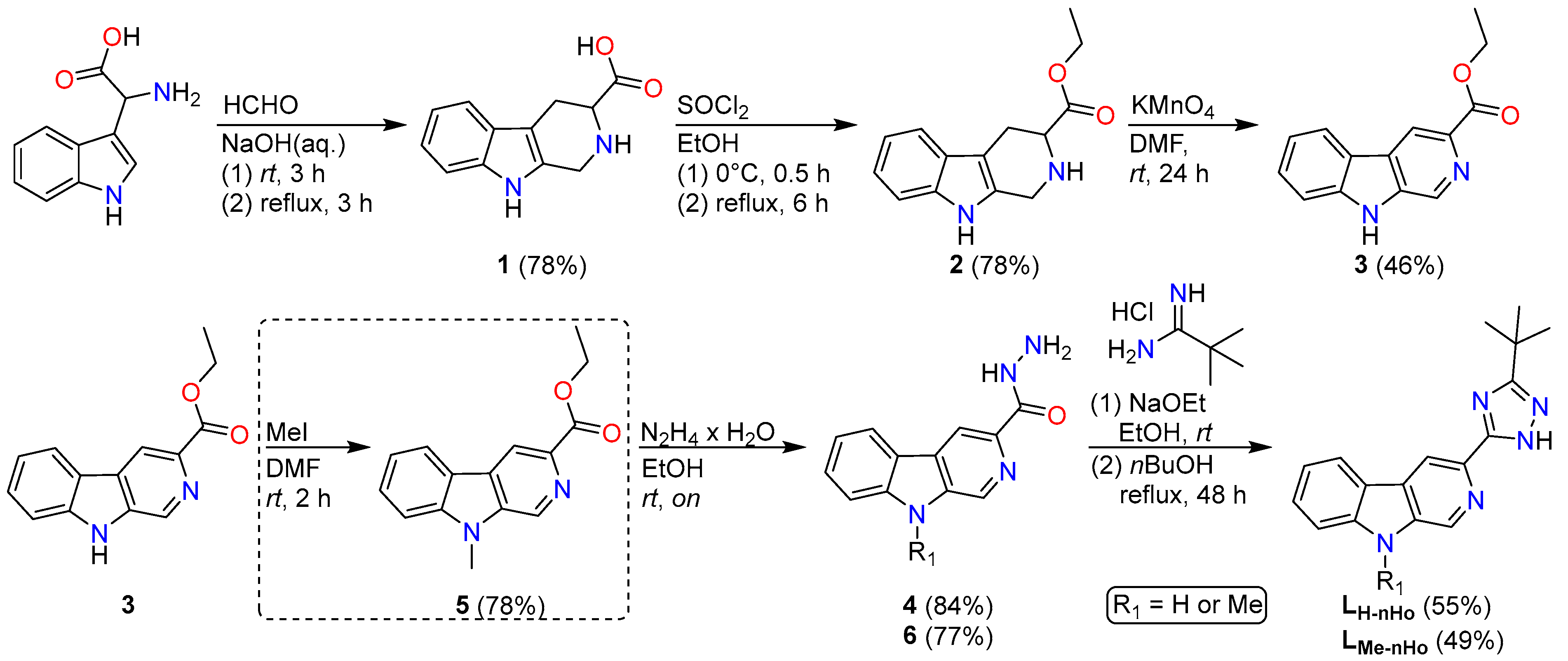
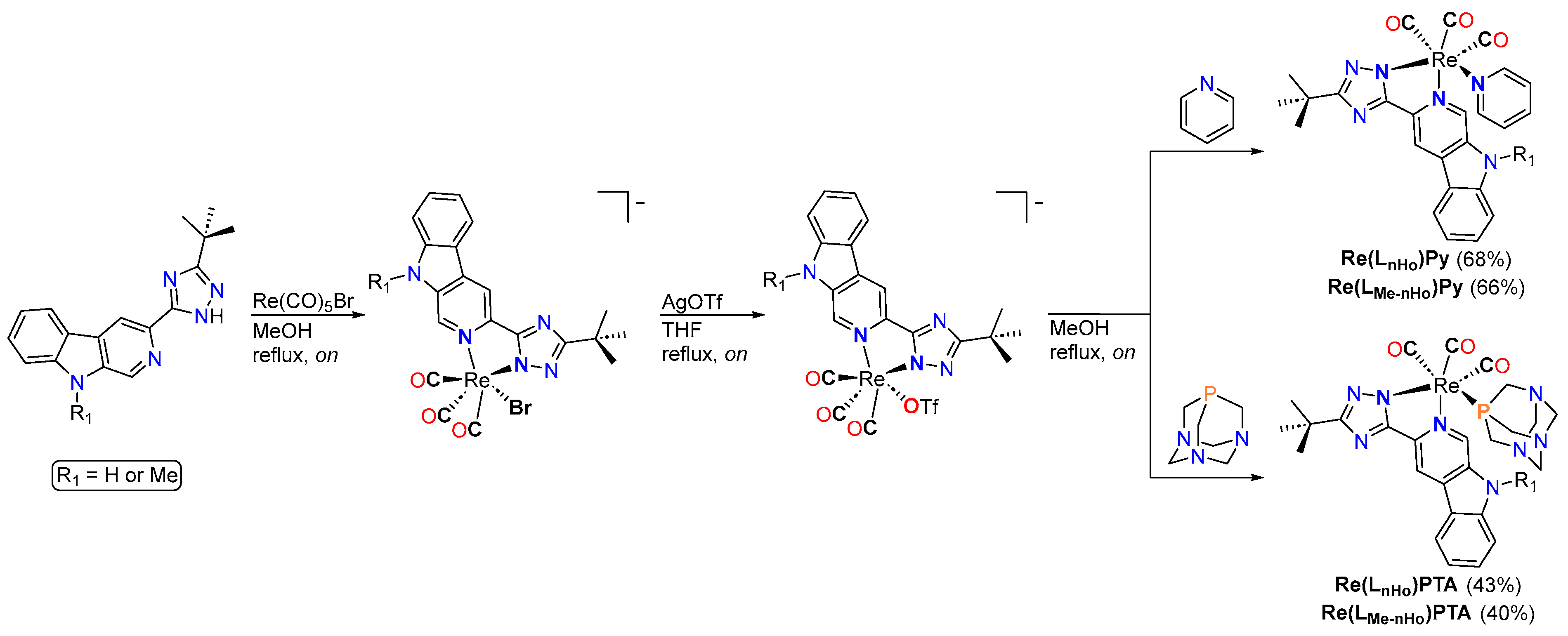
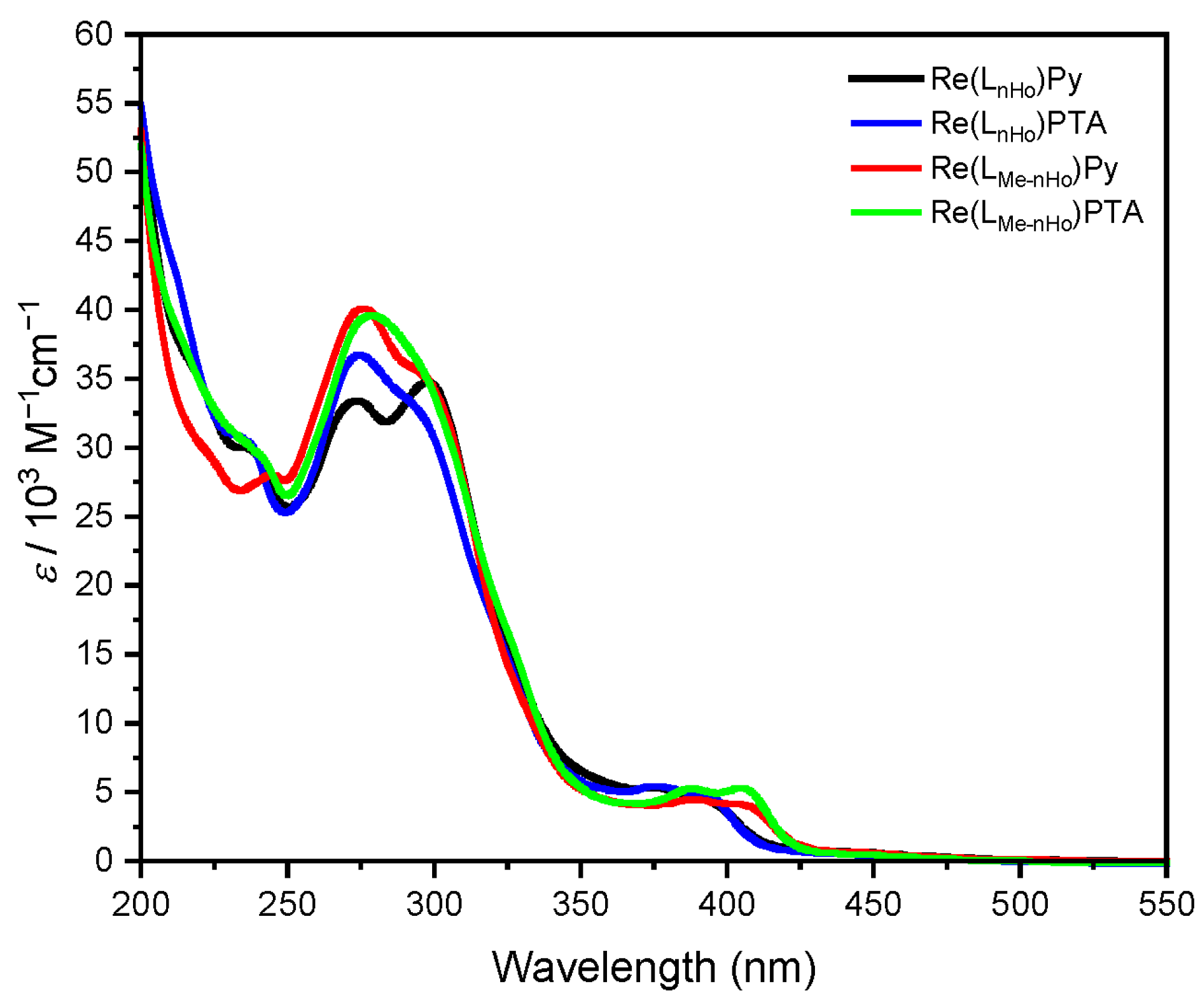
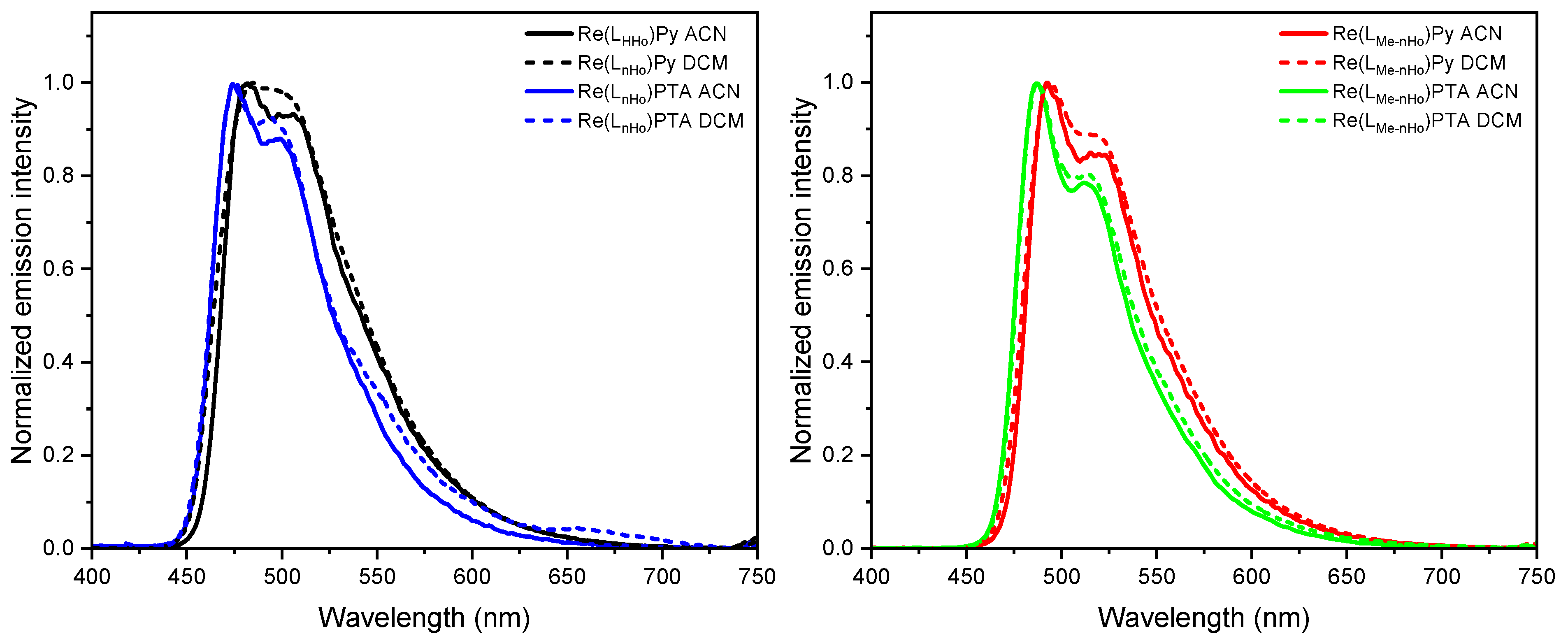
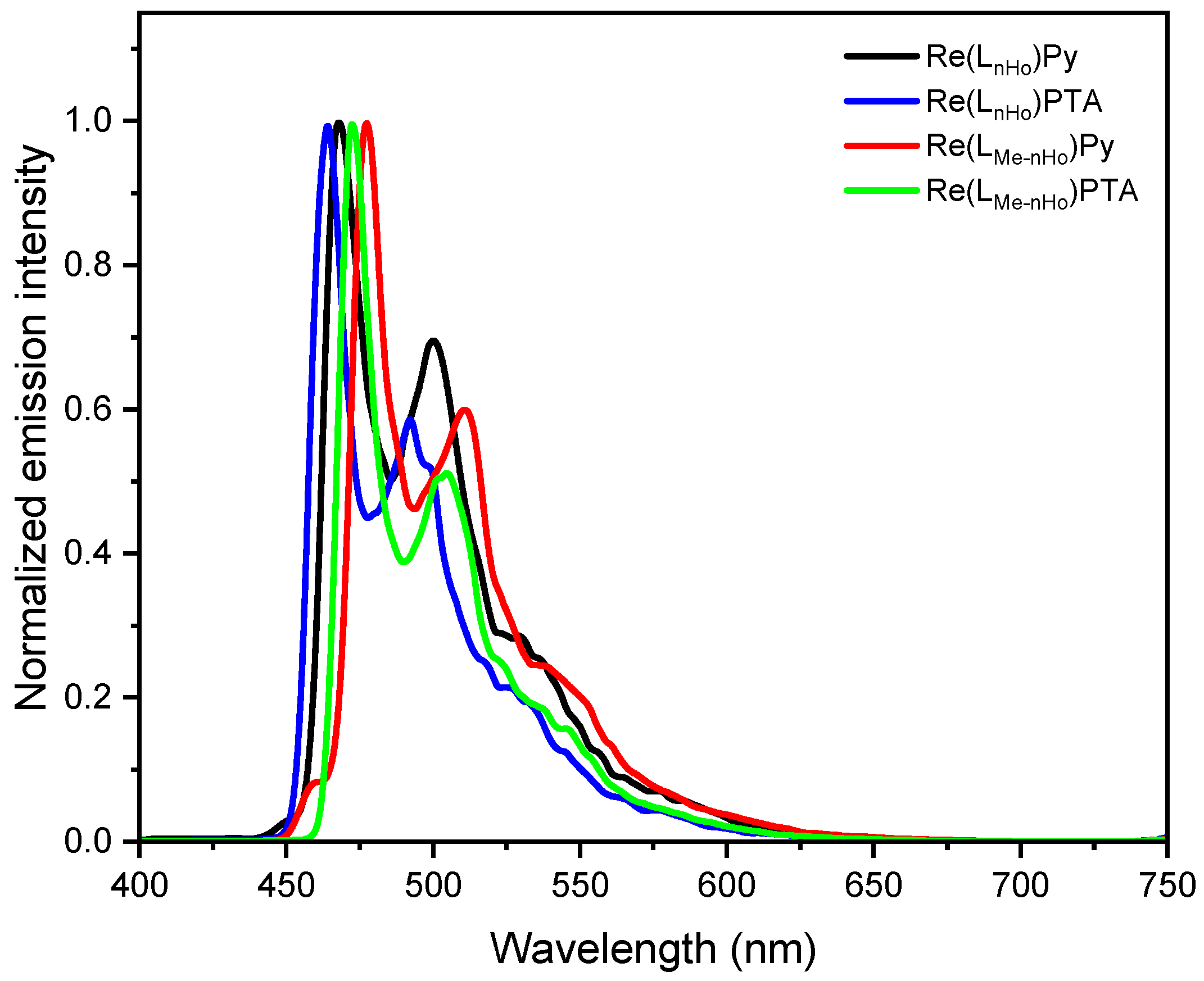
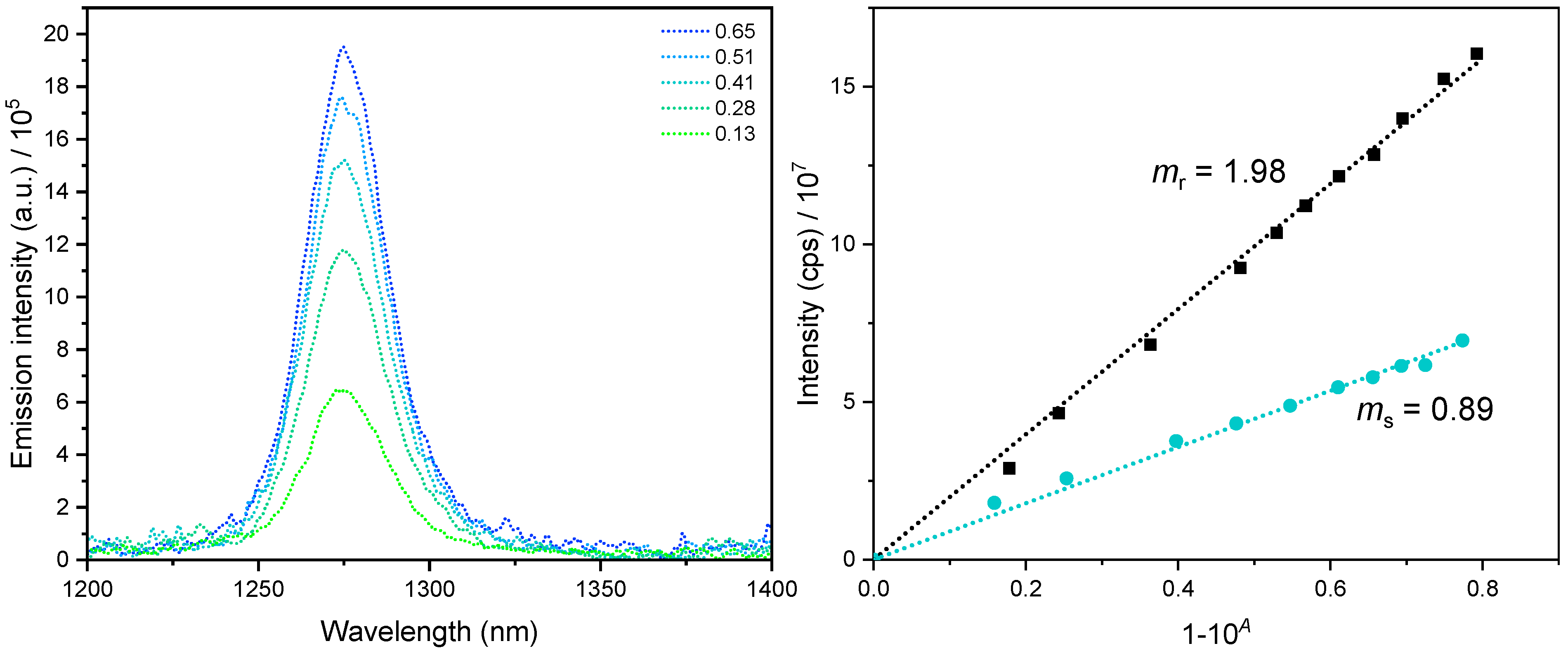
| ΦΔ/% a | /% a | /% a | kq/109 M−1s−1 a | |
| Re(LnHo)Py | 45 ± 2 | 99.50 ± 0.01 | 45 ± 2 | 1.4 ± 0.1 |
| Re(LnHo)PTA | 29 ± 1 | 98.18 ± 0.01 | 30 ± 1 | 2.6 ± 0.3 |
| Re(LMe-nHo)Py | 41 ± 2 | 99.891 ± 0.002 | 41 ± 2 | 1.7 ± 0.2 |
| Re(LMe-nHo)PTA | 39 ± 2 | 99.70 ± 0.01 | 39 ± 2 | 2.7 ± 0.3 |
Disclaimer/Publisher’s Note: The statements, opinions and data contained in all publications are solely those of the individual author(s) and contributor(s) and not of MDPI and/or the editor(s). MDPI and/or the editor(s) disclaim responsibility for any injury to people or property resulting from any ideas, methods, instructions or products referred to in the content. |
© 2025 by the authors. Licensee MDPI, Basel, Switzerland. This article is an open access article distributed under the terms and conditions of the Creative Commons Attribution (CC BY) license (https://creativecommons.org/licenses/by/4.0/).
Share and Cite
Lüke, J.; Maisuls, I.; Hepp, A.; Strassert, C.A. Rhenium(I) Complexes with 2-(1,2,4-Triazol-5-yl)-β-Carboline-Based Bidentate Luminophores and Neutral Co-Ligands: Towards Tunable Phosphorescence and Efficient Singlet Dioxygen Photoproduction. Int. J. Mol. Sci. 2025, 26, 10349. https://doi.org/10.3390/ijms262110349
Lüke J, Maisuls I, Hepp A, Strassert CA. Rhenium(I) Complexes with 2-(1,2,4-Triazol-5-yl)-β-Carboline-Based Bidentate Luminophores and Neutral Co-Ligands: Towards Tunable Phosphorescence and Efficient Singlet Dioxygen Photoproduction. International Journal of Molecular Sciences. 2025; 26(21):10349. https://doi.org/10.3390/ijms262110349
Chicago/Turabian StyleLüke, Joschua, Iván Maisuls, Alexander Hepp, and Cristian A. Strassert. 2025. "Rhenium(I) Complexes with 2-(1,2,4-Triazol-5-yl)-β-Carboline-Based Bidentate Luminophores and Neutral Co-Ligands: Towards Tunable Phosphorescence and Efficient Singlet Dioxygen Photoproduction" International Journal of Molecular Sciences 26, no. 21: 10349. https://doi.org/10.3390/ijms262110349
APA StyleLüke, J., Maisuls, I., Hepp, A., & Strassert, C. A. (2025). Rhenium(I) Complexes with 2-(1,2,4-Triazol-5-yl)-β-Carboline-Based Bidentate Luminophores and Neutral Co-Ligands: Towards Tunable Phosphorescence and Efficient Singlet Dioxygen Photoproduction. International Journal of Molecular Sciences, 26(21), 10349. https://doi.org/10.3390/ijms262110349






